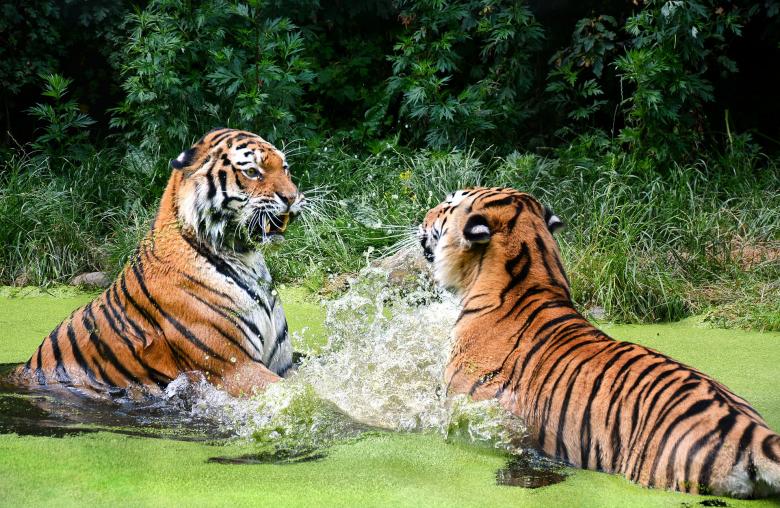ANIMAL: Bengal Tiger Panthera tigris Type of Animal: Feline Habitat: Grassland, tropical/subtropical rainforest, scrub forest, tropical/subtropical deciduous forest, tropical/subtropical dry forest, mangroves, mangrove forest, swampland, monsoon forest, tropical/subtropical evergreen forest, woodland, savanna, rocky areas, floodplains, riverine forest, temperate/subtropical/tropical upland forest Location(s): India, Bangladesh, Burma, parts of Nepal & Bhutan Appearance: Mostly orange w/ black stripes/white belly, male larger than female w/ more distinctive head, heavier look on males. White tigers genetic mutation of Bengal Tiger. Food/Diet: Pigs, primates, bears, foxes, rabbits, hares, civets, deer, cattle, buffalo, antelope, muntjac, goats, sheep, rhino calves, elephant calves, porcupines, equines, jackals, tapirs, dholes, wolves, leopard cubs, clouded leopard, carrion, gazelles, fish, birds, dogs, rodents (including porcupines), reptiles (especially crocodilians, pythons, & monitor lizards). Rare cases of man-eating tigers. Status in Wild: Endangered Conservation: Breeding from zoos & wildlife parks Lifestyle: Solitary, though sometimes siblings live together after leaving mom for a few years & male-female pairs sometimes hunt together/share kills outside of breeding season. Occasionally, small breeding groups of a male & 1-3 females occur. Additional Info: Called: Male-Tiger Female-Tigress Young-Cub Group-Streak Weight: Male-419-569 lbs Female-221-353 lbs Young-18-24 lbs Gestation: 3.5 months Height: Male-3 ft Female-2.6 ft Body Length: Male-8.8-10.2 ft Female-7.11-8.7 ft Life Span: 15 years in wild, up to 20 years in captivity Tail Length: Male-3.58 ft Female-2.75 ft Occasionally, crocodiles prey on adults. These result in fights to death ending up w/ first one dead gets eaten. Large pythons, dholes, wolves, black bears, leopards, male tigers, & hyenas prey on cubs. Endangered due to medicinal trade, habitat loss, logging/deforestation, loss of prey, pet trade, hunting for fur/meat/sport, inbreeding, persecution as livestock/poultry killer/man-eater, & water pollution. Fights over territory fierce, often resulting in death. Sexually mature at 2-2.5 years old. Male tigers kill cubs if given the chance, especially if they're not related to them. Largest populations found in Sundarbans Tiger Reserve on Bangladesh/India border, Kaziranga National Park in India, & Bandhavgarh National Park in India. Each male territory has 3-5 female territories. Fun Fact(s): While there’s 2,500-3,000 of them in wild, many more live in captivity. Around 4,000 live in Texas alone & many are pets. TIGERS DON’T MAKE GOOD PETS!
